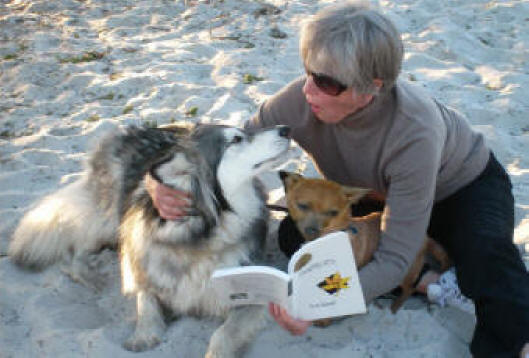 A CASE OF MISTAKEN IDENTITY A CASE OF MISTAKEN IDENTITY
I was introduced to the importance of proper patient
identification in a rather unique way. At our first lecture on avian
anatomy, the professor exhorted us; “Fellas,” he began, “It is so
important for you to learn this material as the standards of care are
changing. Years ago, the standard treatment for any disease of the
parakeet, would be to flush them down the toilet and replace them with a
bird of the same color. You can no longer do this as today’s owners would
not be fooled -- they can actually tell one bird from another!”
Today we live in a world were precise identification
is not only possible, but in most instances is desirable, and in some
instances, mandatory. Computer microchips, injected under the scruff of
the neck, have enabled my staff to reunite several dozen strays, which
were brought in by good Samaritans, with their owners. Recently, several
European countries have made the microchip identification a prerequisite
for entering the country. The technology is cheap, easily applied and
widely available. However, it wasn’t always this way.
Years ago, in the town of Stanton, a
veterinarian with a very kind heart had a practice. He also had a good
sense of humor. One day he was confronted with a dilemma in the form of a
rather truculent woman and her young son. In her hands she had a fishbowl
containing an obviously dead goldfish floating on its side. Her attitude
made it plain that although she knew that the goldfish was dead, she
didn’t want to be the one to tell her son, and expected the doctor to be
the heavy in telling her son that the goldfish was dead. He was not
willing to do what he felt was a parental duty and instead told the woman
and the child that he would try his best to save the fish, and asked the
pair to return in about an hour. The stunned woman couldn’t say anything
aloud in front of her now hopeful child. Within the allotted hour a new
goldfish was procured from the local pet store and placed in the original
fish bowl. It was presented to the delighted child when he returned.
Though the incident smelled fishy, she realized that she had been
outwitted in this identification game and begrudgingly paid the one-dollar
fee.
In the neighboring town of Fullerton,
there lived a veterinarian with great vision. He knew that there was a
need for a simple identification system. He realized this while doing
surgery on a dog that he had spayed a little over a year before. One
month earlier, the owner had brought the dog in because she appeared to be
in heat. Now, this normally shouldn’t occur after a dog has had her
ovaries and uterus removed, but sometimes an ovarian remnant can be left
behind and months later it can be producing enough estrogen to cause an
actual heat to occur. Our doctor offered to retrieve the suspected tissue
once the heat was over and it was safe to reoperate. But what he found
during the surgery surprised him. Instead of having to explore for the
tiny piece of ovary, he found an entire reproductive tract. He suspected
that this might not have been his former patient. He didn’t think that
the client was deliberately trying to be deceitful; after all, she had a
long friendly relationship with the clinic. When he called the client to
inform her of his findings he asked if, by any chance, could the dog have
been out of her care at any time during the past year. She replied, “Only
when she ran away for those two weeks a few months ago. We were so happy
to get her back!” But it was now obvious that her real Sasha hadn’t
returned. But the imposter, by now regaining consciousness from her
surgery, was in fact, so close to the original, both physically and
temperamentally, that the dog was able to successfully integrate in and
fool the entire family! From then on, any animal that that the good
doctor spayed received his trademark brand – one single stainless steel
suture was placed in the abdominal wall to close the incision. The stitch
would be palpable for many years, a sure sign that the doctor had been in!
Years before the plethora of cat rescue groups that have deservedly arisen
in the last several decades, veterinarians were pretty much on their own
when they attempted to place unwanted or homeless animals. Our hero, who
practiced in the Mid Wilshire area of Los Angeles, faced difficult choices
not once, but twice, in the course of his attempt to do the right thing.
He faced his longtime client, a sobbing elderly woman recently devastated
by the loss of her loving husband. Fearing that she could not care for
her cat properly she brought the cat into the hospital and requested that
the doctor euthanize her pet. She had always been a religious lady, but
right now her faith was running on empty. The kindly doctor offered to
keep the cat for a few days in order to try to find a new home. “Tom has
always had the freedom to roam outside, please don’t keep him in a cage
for longer than a week,” she implored. The doctor agreed to comply, but
in spite of his best efforts, he could find no one to take the cat, and as
the end of the week’s time approached, he was faced with a tough
decision. What he decided to do was to place the cat onto the grounds of
a nearby park-like cemetery. There, he felt, Tom could live out his years
in idyllic surroundings. He released the cat and felt good about it.
Several weeks later he got an unexpected call from the now reenergized
elderly woman. “God has sent me a cat just like Tom!” she exclaimed. But
our doctor knew in his heart that somehow, some way, Tom had managed to
find his way back home. To be sure, he offered a free exam for her
foundling. When his examination confirmed Tom’s true identity he wondered
whether he should play along with the charade or tell the truth and risk
upsetting the lady. He opted for the truth and revealed the entire story,
to which she replied, “Then I’ve been doubly blessed.”
She continued to bring “her cat sent from
heaven” back to the clinic for many years.
And they all lived happily ever after.
|






 A CASE OF MISTAKEN IDENTITY
A CASE OF MISTAKEN IDENTITY